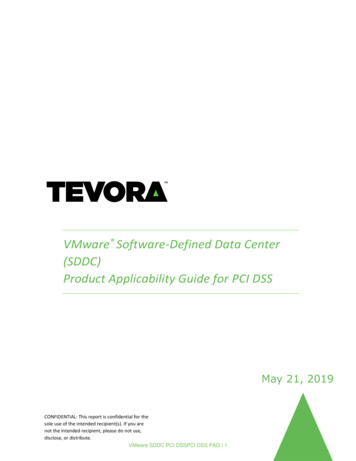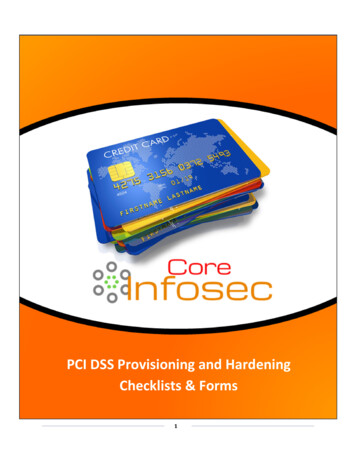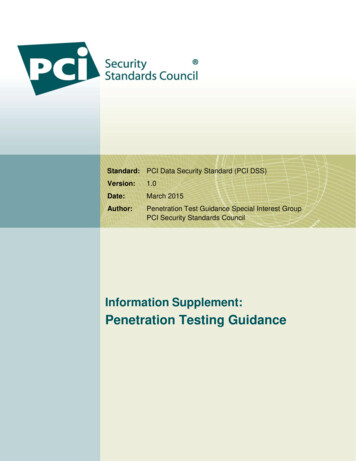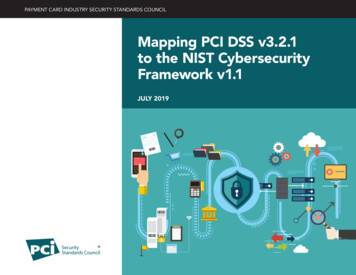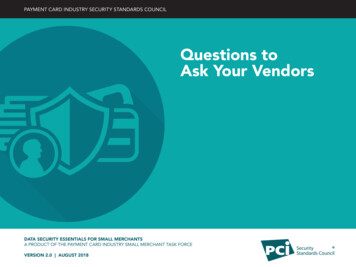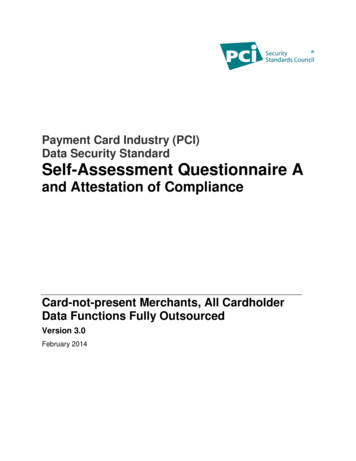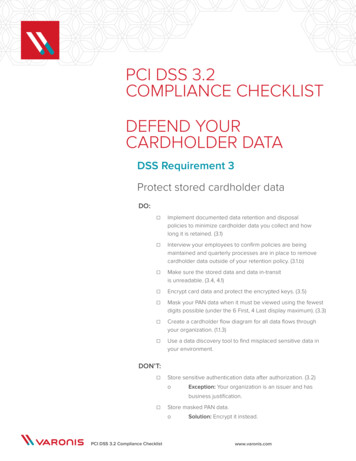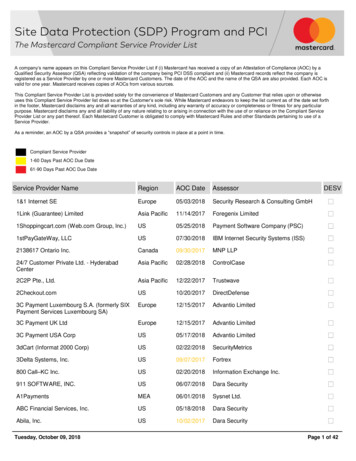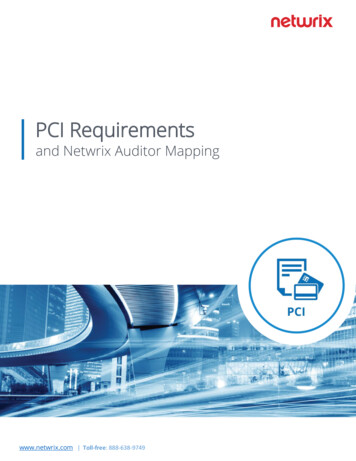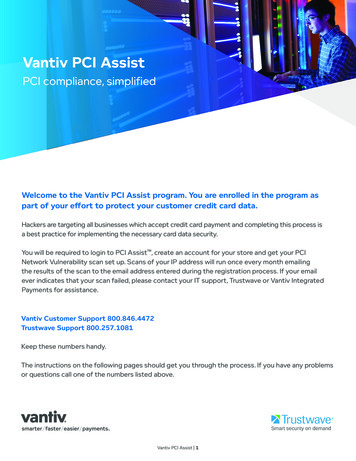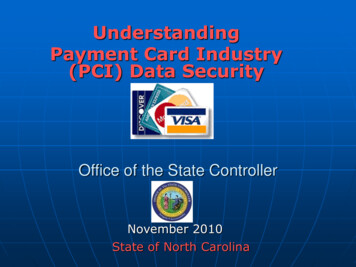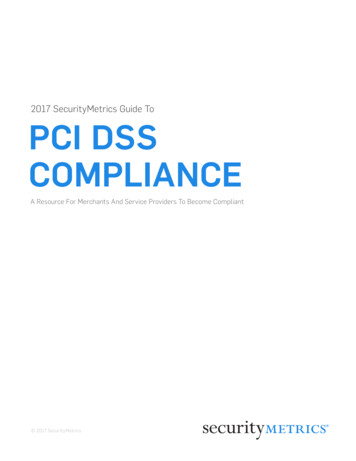
Transcription
2017 SecurityMetrics Guide ToPCI DSSCOMPLIANCEA Resource For Merchants And Service Providers To Become Compliant 2017 SecurityMetrics
2017 Guide to PCI DSS Compliance – 2FOREWORDNo matter the advances in cyber security technology and increased government cybersecurity initiatives and regulations, attackers continue stealing unprotected paymentcard data.Some organizations have simple, easy-to-correct issues that create vulnerabilitiesthat lead to data breaches. In other instances, organizations with intricate IT defensesand processes are overridden by an employee opening a phishing email.We specifically designed this document as a reference guide to help merchants and service providers address the most problematic issues within the 12 PCI DSS requirements,including auditor’s best practices and IT checklists. Rather than reading this guide coverto cover, we recommend using this as a resource for your PCI compliance efforts.I hope the 2017 SecurityMetrics Guide to PCI DSS Compliance will help you betterunderstand today’s PCI requirements and recommended best practices to protectdata from inevitable future attacks.GARY GLOVERSecurityMetrics Vice President of AssessmentsQSA CISSP CISA PA-QSA
2017 Guide to PCI DSS Compliance – 3TABLE OF CONTENTSINTRODUCTION 42017 Data Breach Predictions 5Window of Compromise 8PCI DSS Compliance Trends 13PCI DSS 3.2: Key Changes Overview 17Understanding Your PCI DSS Responsibility 27PCI DSS REQUIREMENTS 33Requirement 1: Protect Your System With Firewalls 34Requirement 2: Use Adequate Configuration Standards 40Requirement 3: Secure Cardholder Data 44Requirement 4: Secure Data Over Open and Public Networks 48Requirement 5: Protect Systems With Anti-Virus 52Requirement 6: Update Your Systems 55Requirement 7: Restrict Access 60Requirement 8: Use Unique ID Credentials 63Requirement 9: Ensure Physical Security 67Requirement 10: Implement Logging and Log Management 72Requirement 11: Conduct Vulnerability Scans and Penetration Testing 77Requirement 12: Start Documentation and Risk Assessments 84PCI DSS BEST PRACTICES 89How to Manage a Data Breach 90PCI DSS Budget 98CONCLUSION 101Contributors 103Terms and Definitions 104About SecurityMetrics 107
2017 Guide to PCI DSS Compliance – Introduction 4INTRODUCTION
2017 Guide to PCI DSS Compliance – Introduction 52017 DATA BREACHPREDICTIONSINTRODUCTIONSecurityMetrics Payment Card Industry Forensic Investigators (PFIs) thoroughlyanalyze the point-of-sale (POS) or E-commerce environments of organizations thatsuspect a payment card data compromise.Through a forensic examination of the in-scope computer systems related to the processing of customer payment card information, data acquired from the breach site canreveal when and how the breach occurred, contributing vulnerabilities, and aspects ofthe IT environment out of compliance with the Payment Card Industry Data SecurityStandard (PCI DSS).SecurityMetrics Forensic Investigators have witnessed the rise and fall of popularattack trends over 14 consecutive years. Here are three predictions for the future:*SecurityMetrics PFIs are Qualified Security Assessors, but do not perform a complete QSA audit of eachPCI requirement during a PCI forensic investigation. PCI DSS requirement data is analyzed to the extentobserved throughout the course of an investigation.1. INSECURE REMOTE ACCESS WILLCONTINUE TO PLAGUE MERCHANTSIn a 2011 security alert Visa stated, “[i]nsecure remote access continues to be themost frequent attack method used by intruders to gain access to a merchant’s pointof-sale environment.” Not much changed in the ensuing five years.This year, 2017, will likely follow similar trends from the latter half of 2016, includinginsecure remote access as the largest single origin of compromise. Since this intrusiontechnique was used in more than 39% of last year’s investigated breaches, hackerswill likely continue using that method until it is no longer effective.Although Europay, MasterCard, and Visa (EMV) reduce the number of at-risk paymentcard accounts, they will not directly impact a hacker’s ability to successfully gainaccess to a merchant’s system through remote access. Unless an easier intrusionmethod presents itself in 2017, it is not likely breach trends in this arena will change.
2017 Guide to PCI DSS Compliance – Introduction 62. LARGE-SCALE POS BREACHES WILL DECREASE,BUT EMPLOYEES REMAIN HIGH-RISKDue to increased EMV implementation in 2016, the frequency of large-scale breachesseen in 2017 headlines should begin to decrease. The decline will be slow at first, untilmore businesses implement EMV-enabled POS terminals and more issuers replaceconventional magnetic stripe credit cards with EMV cards. These two initiativesshould contribute to a decline in the total number of compromised payment cardaccounts from card-present merchant environments.However, as long as human beings are involved, no security solution is 100% secure.Employees inherently introduce the potential for inadvertent employee error, not tomention the increased popularity and sophistication of social engineering attacks. Thepoint of vulnerability in many of 2016’s largest breaches was initiated by the action ofa non-malicious person (usually an employee). The trend of employees leading businesses to compromise through simple actions will continue to occur as long as humanbeings are involved in the payment card process.3. WHILE EMV IMPLEMENTATION INCREASES,E-COMMERCE ATTACKS SHOULD INCREASEAttackers will find it increasingly difficult to obtain customer credit card accountinformation from card-present environments, due to the increased prevalence ofEMV technology throughout the United States. If U.S. EMV implementation followsthe trends of Europe and Canada, we should see a marked decrease in successfulattacks against card-present environments, followed by an increase of attacks againstE-commerce targets.The reality is, there are more than 8 million commercial businesses in the U.S., andmost require new EMV hardware. It is unreasonable to think that every merchant hasimplemented EMV technology. A shift towards E-commerce attacks should correlateto the percentage of EMV adoption.While no environment will be perfectly secure in 2017, the push for EMV, updatedPCI security standard requirements, and improved security technology efforts willimprove the landscape of payment card industry security.
2017 Guide to PCI DSS Compliance – Introduction 72016 SECURITYMETRICS FORENSIC TAKEAWAYS The average organization was vulnerable for 1,021 days Cardholder data was captured for an average of 163 days Cardholder data was exfiltrated for an average of 106 days 39% of organizations were breached through insecure remote access 22% of organizations were breached due to weak passwords 56% of organizations had memory-scraping malware installed on their systemTERMS TO KNOW:VULNERABLE: A system, environment, software, and/orwebsite can be exploited by an attacker.CAPTURED: Data is being recorded, gathered, and/or storedfrom an unauthorized source.EXFILTRATED: Unauthorized data is transferred froma system.
2017 Guide to PCI DSS Compliance – Introduction 8WINDOW OF COMPROMISEINCREASED WINDOW OF COMPROMISEThe window of compromise starts from the date an intruder accesses a businessnetwork and ends when the breach is contained by security remediation. Based ondata collected by SecurityMetrics Forensic Investigators from 2016 breaches, it tookan average of 844 days from the time an organization was vulnerable for an attackerto compromise the system. The average organization was vulnerable for 1,021 days.Nearly every organization will experience system attacks from a variety of sources.Due to inherent security weakness in systems or technology, some organizations havesystems, environments, software, and/or website weaknesses that can be exploitedby attackers from the day their environment is set up. In other cases, an organizationbecomes vulnerable because they fail to apply a security patch or make systemmodifications without properly updating related security protocols.Once compromised, attackers had access to the sensitive data for an average of163 days in 2016. This may be attributed to aggregation methods employed by datathieves. Attackers have been known to save sensitive data from malware scraping (orother tools), without using or selling the data for months to years.Using this aggregation method prevents organizations from identifying malicious account activity too early, which would expose the data breach much sooner and greatlylimit the amount of sensitive data attackers could acquire.TOP 5 CATEGORIES OF FAILED VULNERABILITIESDURING VULNERABILITY SCANS TLS Version 1.0 Protocol Detection SSL Certificate with Wrong Hostname Web Application Potentially Vulnerable to Clickjacking SSL RC4 Cipher Suites Supported (i.e., Bar Mitzvah Attack) SSL Self-Signed Certificate
2017 Guide to PCI DSS Compliance – Introduction 9IMPROVE PROCEDURES TO DECREASETHE WINDOW OF COMPROMISEWhen an environment isn’t actively monitored, breaches are more likely to go undetected for longer periods of time. The sooner a breach is detected; the less damage anattacker can do to a business. Your goal should be to create and practice the necessary procedures to protect data and warn of abnormal behavior in an environment thatinteracts with sensitive data.From a forensic point of view, logs and audit trails are crucial to proving how, or if, anorganization was compromised. Keeping track of critical actions (e.g., access to files,login attempts) can help identify key attack elements. Logs help track actions to anindividual user and determine potentially suspicious activity. Assigning unique useridentification also creates an atmosphere of accountability and may deter internalsystem abuse.Once suspicious activity has been defined within an environment, intrusion detection/intrusion prevention systems (IDS/IPS) can be configured to notify of activity thatmight indicate an attack.Change detection programs like file integrity monitoring (FIM) are especially useful forE-commerce environments because they track the original state of a file and reportany changes, such as when an attacker hides malware within an otherwise legitimatefile or application.SECURITY TESTINGThe two major types of vulnerability testing that should be performed in every merchant environment include penetration testing and vulnerability scans.Penetration tests are a thorough vulnerability testing approach in which analystsidentify potential weaknesses and attempt to exploit vulnerabilities. For example,penetration testing is particularly helpful for companies developing their own applications, as it’s important to have code and system functions tested by an objective thirdparty. This helps find vulnerabilities missed or created by developers.Vulnerability scans are automated, affordable, high-level tests that identify certainweaknesses in network structures. Robust vulnerability scans can identify more than50,000 unique external weaknesses. In addition to locating and reporting vulnerabilities, typical vulnerability scans also encourage a recurring and reliable process for repairing discovered problems. After a scan completes, it’s necessary to repair locatedvulnerabilities and re-scan to confirm that vulnerabilities have been addressed.
2017 Guide to PCI DSS Compliance – Introduction 10SECURITY POLICY AND EMPLOYEE TRAININGHaving clearly written policies and communicating those policies continuously toemployees is a critical part of having a secure environment. If management pushesa security culture through company policies, it gives the why that guides employeesdecisions. If there is no why, people may fail to correctly implement controls andpractices, or may implement them sporadically and leave gaps in security.One pitfall, even in the most protected environment, involves the introduction ofmalicious content by human error. Activities as simple as employee email access orunauthorized Internet browsing can allow paths to and from untrusted networks.Employees often inadvertently introduce malware into merchant systems by simplyopening email attachments, downloads, or USB drives. They are often unaware ofthe threat they just allowed into the system. Creating, instructing on, and enforcing asound security policy is the best way to secure an environment from employee error.THE REGULAR ROUTINE OF WORKMAKES IT EASY FOR EMPLOYEESTO FORGET CRUCIAL SECURITYINFORMATION LEARNEDDURING TRAININGS.
2017 Guide to PCI DSS Compliance – Introduction 11RISK ASSESSMENT AND MANAGEMENT PLANA formal risk assessment should occur at least annually and after any significantnetwork changes to identify threats and vulnerabilities. Risk assessments help avoidbreaches by keeping you up to date with current trends, technologies, and threats.They also provide direction on next-step compliance efforts.Addressing vulnerabilities decreases the time an attacker can compromise the system(i.e., window of compromise). Vulnerability management plans that identify youranti-virus software, patch management, coding, and control changes are particularlyhelpful. Plans help identify, classify, remediate, and lessen future instances of vulnerabilities. Creating a vulnerability management plan is central to decreasing thewindow of compromise.A RISK ASSESSMENT SHOULD OCCUR AT LEASTANNUALLY AND AFTER ANY SIGNIFICANT NETWORKCHANGES TO IDENTIFY THREATS AND VULNERABILITIES.However, just because a system is vulnerable doesn’t mean it’s exploitable or likely tobe exploited. Some vulnerabilities may require such a large number of preconditionsthat the chance of a successful attack is virtually absent. According to PCI requirement 6, identifying the differing levels of exploitability should help an organizationprioritize its actions to enhance IT security based on each identified vulnerability’sperceived
*SecurityMetrics PFIs are Qualified Security Assessors, but do not perform a complete QSA audit of each PCI requirement during a PCI forensic investigation. PCI DSS requirement data is analyzed to the extent observed throughout the course of an investigation. 1. INSECURE REMOTE ACCESS WILL CONTINUE TO PLAGUE MERCHANTS In a 2011 security alert Visa stated, “[i]nsecure remote access continues .
